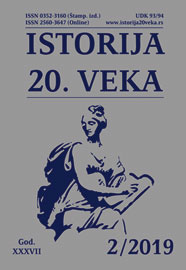TRI POČETKA SRPSKOG IGRANOG FILMA: NAČINI NARACIJE I DRUŠTVENI KONTEKST
THREE BEGINNINGS OF THE SERBIAN FEATURE FILM: MODES OF NARRATION AND SOCIAL CONTEXT
Author(s): Oleg JeknićSubject(s): Fine Arts / Performing Arts, Film / Cinema / Cinematography
Published by: Institut za savremenu istoriju, Beograd
Keywords: Cinematography; Narration; Narrative Model; Film History; Dramaturgy; Serbia; Yugoslavia
Summary/Abstract: This article analyzes the narrative structure of Serbian feature films of the first half of the 20th century. The aim of the research is to show how social circumstances favor certain narrative modes. The author finds Serbian cinematography (referring to the territorial definition of the term) particularly suitable for this research because it is characterized by discontinuity, which was the result of two world wars. Lack of tradition and complete interruptions in the production of fiction films have created conditions in which the formation of a dominant narrative mode were more influenced by social than by professional circumstances at every new cinematic beginning. By exploring the reflections of the social context that are visible in narrative modes, the depth of change that the Serbian society experienced in the observed period becomes more obvious. There are three beginning of Serbian fiction film: in 1911 the first feature film was made in the Kingdom of Serbia, in 1922 production was restored in the Serbian part of the Kingdom of SCS, and in 1947 the first feature film in socialist Serbia was filmed. The basis for the analysis and systematization of film narration is the theory of David Bordwell, which differentiates between three basic narrative modes: classical Hollywood narration, art-cinema narration and historical-materialist narration. The conclusion of the research is that the Serbian feature film was initially influenced by the art-cinema narration, above all French; that the dominant mode between the two world wars was Hollywood narration; and that after the Second World War Serbian feature film was structured in accordance with the norms of the Soviet historical-materialist narration. Despite such discontinuity, some common features link those films: the melodramatic structure of the plot, the female characters as the bearers of meaning, the atmosphere of endangerment, and the necessity of sacrifice for the common good.
Journal: Istorija 20. veka
- Issue Year: 2019
- Issue No: 2
- Page Range: 65-84
- Page Count: 20
- Language: Serbian

